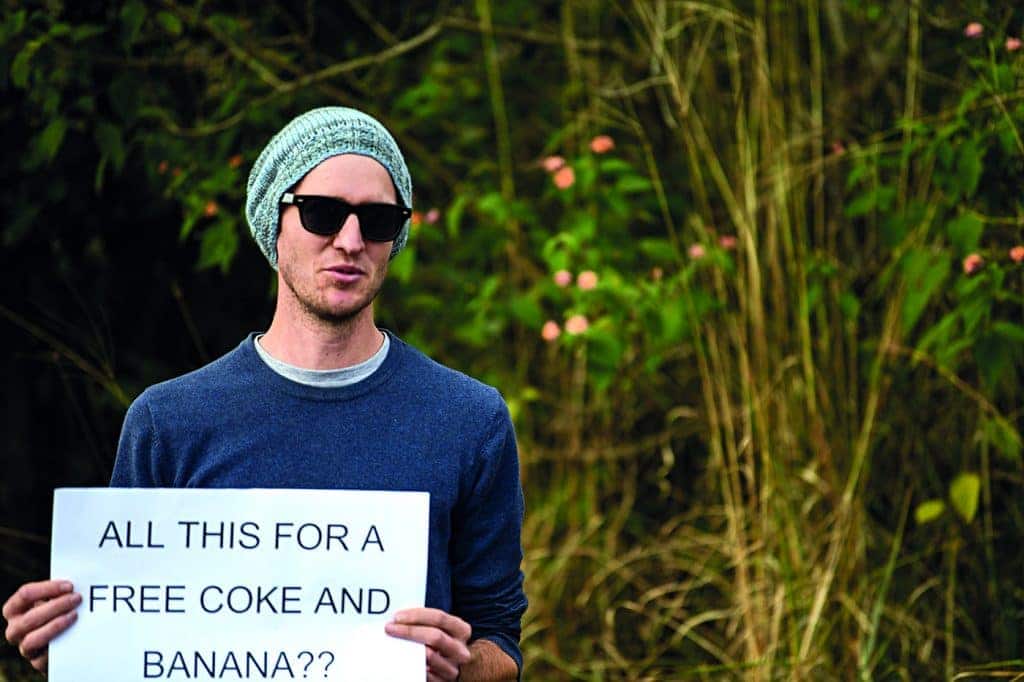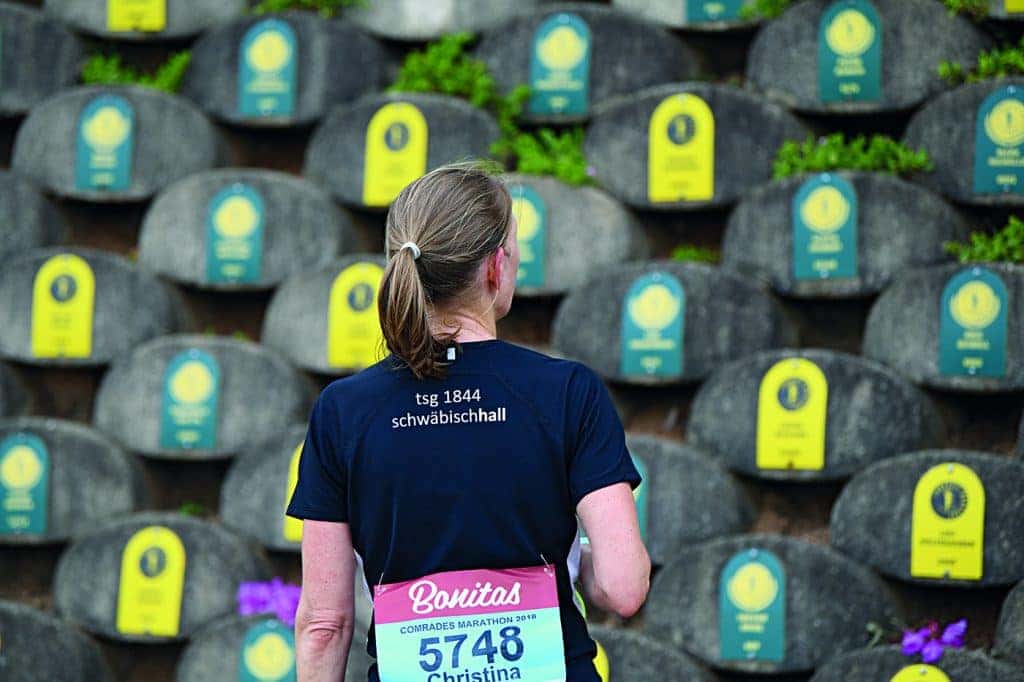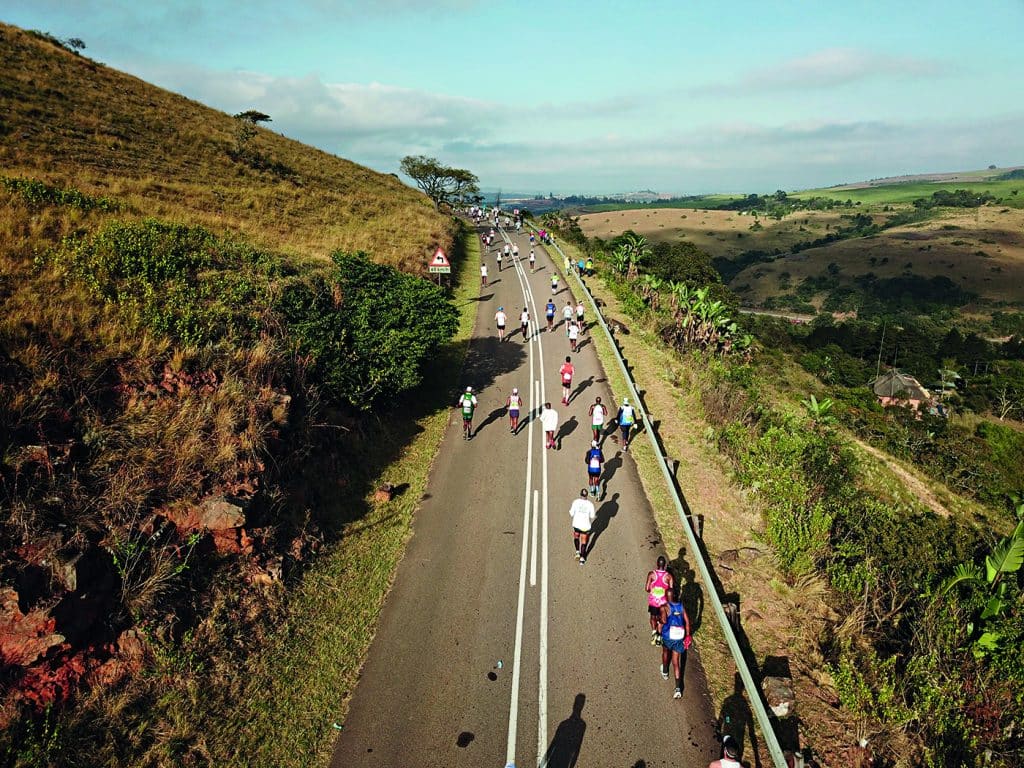Comrades: An Ode To The World’s Greatest Footrace
90 brutal kays. Five torturous climbs. A ruthless clock. The Comrades Marathon may be the world’s greatest race – But not because it’s easy…
Every run is a new adventure; and every race exists only to expose some piece of us. The greater the race distance, the deeper the unpeeling. This makes the Comrades Marathon a long and probing quest.
I first heard about Comrades’ length, hills, and amazing traditions four decades ago. Since then I have considered it the world’s greatest footrace. But until I ran this race, I didn’t realise how much a race could reveal to me. Of me. Some races are humbling; this one stripped me bare.
The distance alone makes Comrades intimidating. The infamous climbs make it torturous. At midway, the course snakes upwards through the Valley of a Thousand Hills, an English appellation as accurate as it is terrifying. The mightiest of these ascents is Inchanga, an unnerving drum roll of a Zulu word. Just beyond lie the Drakensberg Mountains, which gave life to the most famous lines of South African literature – lines that never fail to stun me with their simple beauty. Alan Paton was still director of a reform school when he wrote them on the first page of his masterwork, Cry, the Beloved Country: “There is a lovely road that runs from Ixopo into the hills. These hills are grass-covered and rolling, and they are lovely beyond any singing of it.”
Last June, as I ran and walked through the Valley of a Thousand Hills, I snatched glances into the distant Drakensberg and thought about Paton. He got it right. These hills are dazzling indeed – a crescendo of one sweet green slope rising above another. They are interrupted only by a few tumbling rivers, like the Duzi and Umgeni, and by white puffs of smoke from clusters of clay huts with thatch roofs. Looking out at these hills, I felt transported to a lush, untrammelled and bygone era.

But then my hard, raspy breathing clawed me back. I heard groans and imprecations from runners around me. And I had a different thought: Paton was a novelist-poet. He took the train, for goodness’ sake, never once attempting to run these horrid hills. If he had, he would have seen them in another light.
Trust me.
On Comrades Marathon morning, I simply walk out my hotel’s back door at 4:30am and follow everyone else towards the starting line 2km away. The pace is relaxed now, no need to hurry. I have time to consider what brought me here.
The answer couldn’t be simpler. The way I figure it, Comrades has to be the world’s greatest race. I mean, it’s 90km long – the type of distance that usually lures about… oh, 71 runners. Comrades has enough magnetism to draw 20 000-plus.
No other race produces such an astonishing sound mix.
En route to the starting line, I stop counting Comrades traditions when the music begins. No other race produces such an astonishing sound mix. A gaggle of South African club runners jogs past, singing high harmonies in the manner of Ladysmith Black Mambazo. Three months earlier, I had told a Ladysmith member that I was headed to Comrades. He shook his head slowly and let out a soft whistle. He knew about the race. Everyone in South Africa is a Comrades aficionado, thanks to the continuous TV coverage. Twelve hours. Live. National TV.
Shosholoza
This accounts for the brilliant spotlights that bathe us at the start, where the runners break into a spontaneous rendition of ‘Shosholoza’. It’s an old Zulu mining song, and its title means, roughly, “Keep going. Move faster on those mountains.” It’s followed by the pulsing Chariots of Fire theme. But all ears eagerly await the next sound: a cock’s crow. In 1948, on the morning of his eighth Comrades, local runner Max Trimborn – one of 44 entrants that year – couldn’t contain his nervous energy on the starting line.
He needed to do something… anything. So he cupped his hands, filled his lungs, and issued a lusty rooster crow. The other runners so enjoyed this homey touch that they demanded repeat performances in subsequent years. Trimborn obliged for the next 32, sometimes adorning himself with feathers and a rooster vest. By the time of his death in 1985, Trimborn’s crowing had been preserved on tape. These days, greatly amplified, it still starts the Comrades Marathon: “Cock-A-Doodle… Go!”
A race this long demands a plan and a goal. I have both, but mainly the latter. The plan is to take it easy. (Duh.) While I haven’t done any long runs, I’m in good shape, based on a recent 1:29 half-marathon. I aim to extend my endurance with walking breaks. When I feel good, I’ll run. When I get tired, I’ll walk. You see how easy these ultramarathons are?
RELATED: 20 Fun Facts About The 2019 Comrades Marathon
My primary goal is much more specific: I want to run all the way up Polly Shortts. No, I didn’t say Polly’s shorts, but now I must explain. Animal lovers can name Africa’s ‘Big Five’ in a flash – elephant, buffalo, leopard, lion, and rhinoceros. Those who run the ‘Up’ Comrades are just as quick with its Big Five hills – Cowies, Fields, Bothas, Inchanga… and Polly Shortts, the last and most treacherous. When I first heard these names, back in my college days, I could barely suppress a chuckle. They seemed so plebeian. The hills I feared had monikers like Heartbreak, Cardiac, and Doomsday. Polly Shortts? I couldn’t picture anything but a girl in a miniskirt. (Hey, it was the 1960s, okay?)
The first kays pass easily, almost eerily. It’s quiet in the throng of runners.
After the cock’s crow, I jog cautiously through the cool, dark streets of Durban, concerned about tripping over other runners or their discarded clothing. The first kays pass easily, almost eerily. It’s quiet in the throng of runners. Maybe no one’s awake yet. Or everyone’s simply harbouring their energies for the long day ahead. I see the occasional Zulu woman on the sidewalk, collecting shirts and sweaters discarded by warming runners. Grey-bearded Hindu men in turbans watch passively. Durban is a polyglot town. Mahatma Gandhi lived near here for 20 years, and in 1906 began using non-violent demonstrations to protest South African law. A decade later, he took this tactic home to India.

In these early kays, there’s little room for walking breaks. The roads are narrow, the pack thick. After 5km, I spot several openings and scoot to the side of the road to walk for a minute or two. I seem to be alone in this approach. Everyone else is still running. That’s okay. I’m in no rush to beat anyone. The more strength I save now, the more I’ll have later, when I really want it, when I meet my Polly. A bright sun rises in the east, bathing the verdant countryside in brilliant colours. All’s well with the world. “This is easy,” I tell myself. “You can do this all day.”
At about 15km, I reach the first hill, Cowies. It’s no big deal – just a sharp turn and a long, gradual slope up and around a big shoulder. I take a few short walk breaks. All fine. Just a few more kays to the half-marathon mark.
Half Marathon Point
Kays Completed: 21km
Elapsed time: 2:30
Mind: Supreme confidence.
Body: Fit, rested.
Overall: Hey, Comrades is long, but so is life. I’ve got plenty of time.
The first killer hill, Fields, begins at about 21km. It’s long, steep, and grinding. Since almost everyone is walking, I decide to do the same and make some new friends. That’s one of the great things about an ultra. When you go this long and slow, there’s time for bonding. I spot two middle-aged guys in identical singlets. Running with buddies is an important theme at Comrades – dare I say, a tradition? Comrades was started in 1921 to pay tribute to South Africa’s WWI veteranss. These days, ‘comrades’ refers more often to your training and racing partners. If you get a bunch of them together for what Americans could call a ‘pace team’, it’s known as a ‘bus’. That’s the best way to run Comrades: hop on a bus.
Stories Tumble Out
I ask the two guys if they’re friends. The stories tumble out. One is running his fifth Comrades, the other is a newbie. I jokingly inquire as to what took him so long. “I had to find something to celebrate my 50th birthday,” he says. “Some men get divorced, some men buy sports cars, and some men set sail around the world. I decided to run the Up Comrades.”
I can’t help thinking that most guys who turn 50 choose to sit down and wait for the moment to pass. But I keep that thought to myself. Mr. Fifty is looking pretty beaten up already, and I doubt he’ll appreciate any attempts at humour or perspective.
RELATED: Your Day-By-Day Countdown To Comrades 2019!
I’m starting to feel thirsty, so I head for a water table.
Three kilometres past Bothas, we cross the marathon mark. And I’m feeling it. Not a good sign.
I quench my thirst on cups of Coke and begin to climb up Bothas, which follows soon after Fields. Or maybe they are the same. I suspect some devious Comrades mapmaker of using two names to imply a respite between hills. Three kilometres past Bothas, we cross the marathon mark. And I’m feeling it. Not a good sign.
Marathon Point
Kays covered: 42,2km
Elapsed time: 5:10
Mind: With the worst hills done and gone, maybe it’s time to think negative splits.
Body: Thank goodness the second half is mostly flat.
Overall: When this thing is done, it would be nice to take a holiday. At the beach. With deck chairs and a nearby bar.
Just beyond the marathon mark, we run through the halfway, basically the longest balloon arch/water stop/musical review I’ve ever seen. It’s at least 200 metres from one end to the other. I tarry, drink a little Coke, eat half a baked potato (a Comrades speciality), and try to relax. This might be possible except for one supreme obstacle: Inchanga. It fills the view ahead – climbing, curving left, and soaring ever higher like a roller-coaster on steroids.
Yes, the Alan Paton scenery in the distance is spectacular, but an ultra crushes your appreciation for aesthetics. It turns you inward, where a nagging voice says, “Put your head down. Focus. Get through this mile…then the next one.” I walk most of Inchanga. It takes 30 minutes. All I see is black asphalt with narrow zigzag fissures. I’m still thinking: “Save yourself for Polly.”
Beyond Inchanga, we pass the Ethembeni (‘Place of Hope’) School for blind and physically handicapped children. Its students line the roadside in their wheelchairs, on canes, on crutches. No Comrades runner, no matter how fatigued, can pass here without acknowledging his or her own good fortune. I jog over to the kids and slap fives, as many as I can.
Ultra Marathon Point
Kays covered: 62km
Elapsed time: 8 hours
Mind: This sucks.
Body: This sucks.
Overall: This – how should I put it? – sucks.
Polly, Polly, where are you? I’ve been walking for five kays, from about the 72km mark. It’s a desperate move – one that I hope will conserve what little strength I have left. Maybe, I tell myself, maybe I can still run up Polly Shortts.
The sun is high in a cloudless sky, the temperature in the mid-20s, and most sensible South Africans have settled into deck chairs, cracked open a beer, and fired up their braais.
As I walk toward Polly, wondering where she is and how she will appear, I try to puzzle out what has gone wrong. This yields nothing. I’m in good shape, I’ve followed a conservative pacing strategy, and I’ve eaten and consumed fluids judiciously. Normally, I’m an ace at assessing my fitness. In those predict-your-time races, I always take a top prize. Today, however, I have lost all will. I don’t have blisters, cramps, creaky knees, or any of the usual runner afflictions. I’m not dizzy and light-headed in a bonking sort of way. But my brain has gone AWOL; it won’t tell my legs to get going. I can’t explain this; I am merely reporting.
I see hundreds of runners. All are walking.
A large signboard at the bottom of Polly Shortts announces her entrance. I lift my eyes – a mistake. Ahead is the sharpest hill of the day, rising wantonly upward until it slithers out of view. I’m guessing there’s more of the same over the horizon. I see hundreds of runners. All are walking. And there is no chance, despite my planning and resolve and name mockery and chatting with Bruce Fordyce, that I will run Polly Shortts. Not a chance. My tank has passed empty. So I trudge onward, sidling over to a green-numbered runner, one of the veterans. I can’t stop myself from whining. I explain how, prior to beginning today’s ordeal, I had believed the Up Comrades might be easier than the Down. We all know the perils and pains of downhill running, right?

I Walk Every Step
I walk every step of Polly Shortts, and every step of the remaining 10km to the finish. The whole world waddles past me, or at least it feels that way. I get passed by tall, skinny guys with thick dreadlocks hanging to their waists. I get passed by short, fat guys in grass skirts. I get passed by lean, elegant women with purple fright wigs, and short, fat women in tutus. As we get closer to Pietermaritzburg, the course turns blessedly, run-ably downhill, and I still can’t break out of my walk. A spectator bolts from her deck chair and races to the pavement, her eyes fixed on mine. “You’re a hero,” she yells into my face. “Don’t stop. You can do it.” I’m too tired to turn and see if there’s another, worthier runner behind me, as I imagine there must be.
A kay from the end of the race, I hear the first faint echoes from the finish-line announcer. The race winners have broken the tape more than four hours ago. Here, in another 60 minutes, running’s most dramatic moment will be played out. At precisely 11 hours 59 minutes on the time clock, the director of the Comrades Marathon Association will emerge from a tent and march to the finish line. There, dressed in a dark jacket and tie, he will turn around, his back facing the oncoming stream of runners. He will raise a gun and wait for the seconds to tick down.
The crowd breaks into a rhythmic, throbbing chant: “Go…Go…Go…Go…”
All around, pandemonium breaks loose. Thousands of spectators stare at the executioner, imploring, “No. No. Don’t do it.” Then they look the other way, to the frantic flow of runners struggling for the finish. Some are sprinting with joyously upraised arms, some walking, some being carried by teammates, some literally crawling on their hands and knees. The crowd breaks into a rhythmic, throbbing chant: “Go…Go…Go…Go…” The atmosphere is electric, the suspense building. The national television audience skyrockets in the final minutes, as all South Africa tunes in for the tense Comrades conclusion. Who will make it? Who won’t?
At 12:00:00 on the race clock, the gun is fired, and the Comrades Marathon is over. Those who fail to break 12 hours will receive no medal for their effort. No time. They won’t appear in the newspaper or the official results programme. If you want, you could tell your friends that you ran Comrades. You could say you finished in, oh, 12:20. But you didn’t. Because there is no record of it. You would have been better off spending the day around the braai.
I will beat the 12-hour cut-off by 55 minutes, but I’ve also run the worst race of my life, and I don’t know why. This bugs me, but there’s nothing I can do about it. When I finally reach the last metres I can only console myself that I didn’t give up. I’m not proud of the way I finished, but I am proud that I did finish. And the reward was great. I’ve got what I wanted, what I wanted badly – a Comrades Up medal. Every runner should have one.
READ MORE ON: comrades comrades-marathon ultra-marathon

